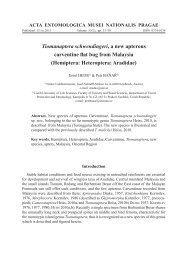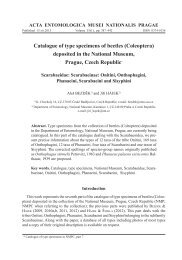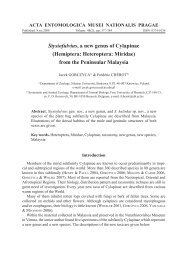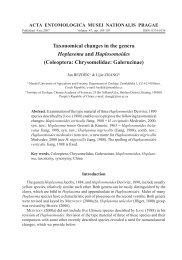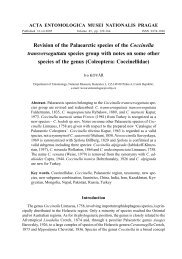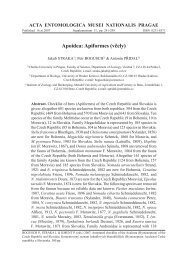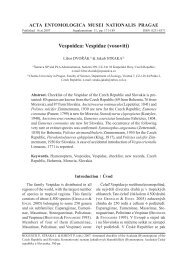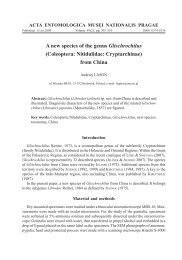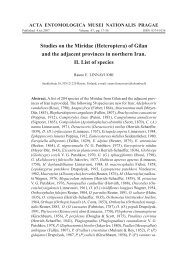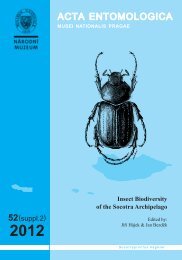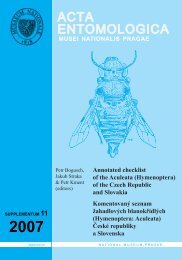(Hemiptera: Heteroptera: Miridae: Phylinae) from Morocco - Acta ...
(Hemiptera: Heteroptera: Miridae: Phylinae) from Morocco - Acta ...
(Hemiptera: Heteroptera: Miridae: Phylinae) from Morocco - Acta ...
Create successful ePaper yourself
Turn your PDF publications into a flip-book with our unique Google optimized e-Paper software.
<strong>Acta</strong> Entomologica Musei Nationalis Pragae, 48(2), 2008 421<br />
Figs. 2-10. Megalocoleus stysi sp. nov. (male holotype: 2 to 8). 2 – head, lateral view; 3 – antenna; 4 – hind tarsus;<br />
5 – claw; 6 – vesica, lateral view; 7 – apex of vesica, different angle; 8 – left paramere; 9 – vagina, dorsal view; 10<br />
– detail of left ring sclerite of vagina.<br />
Genitalia. Male: vesica slender, U-shaped; with a thin, straight and acute apex (Fig. 6);<br />
secondary gonopore removed far <strong>from</strong> apex of vesica (Fig. 7); left paramere as in Fig. 8.<br />
Female: vagina large and oval (Fig. 9). Ring sclerites subtriangular (Fig. 10).<br />
Differential diagnosis. Megalocoleus stysi sp. nov. shows some similarities with M. lunula<br />
(Fieber, 1861) in the colouration and vestiture but differs <strong>from</strong> the latter species in the structure<br />
of the vesica. The vesica of M. stysi sp. nov. is thin with a straight apex and the secondary<br />
gonopore is removed far <strong>from</strong> the apex of the vesica, while the vesica of M. lunula is thicker<br />
with a curved apex and subapically placed secondary gonopore. The vesica of M. stysi sp. nov.<br />
is similar to that of M. krueperi (Reuter, 1879), but the latter species is easily distinguished<br />
by its general shape, short and incrassate antennae, and vestiture (see MATOCQ 2004).<br />
Megalocoleus stysi sp. nov. runs to couplet 12 in the key presented by MATOCQ (2004). A<br />
third choice can be added at that point to accommodate M. stysi sp. nov. in the key. Asterisk<br />
(*) means that an examination of the male genitalia is necessary to identify the species with<br />
certainty.



